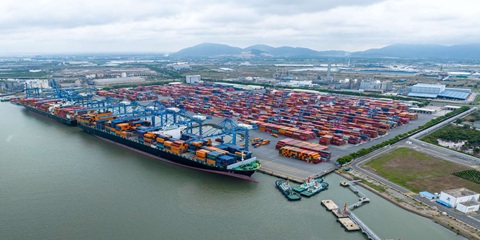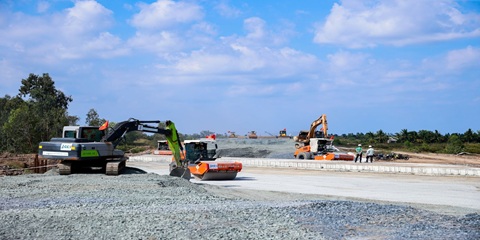Want to be in the loop?
subscribe to
our notification
Business News
SEAPORTS LAG BEHIND REGIONAL PEERS
Despite growing demands, Vietnam’s seaport development masterplan has been deemed inappropriate by experts, leaving much to be desired in the race to attain capital.
Vietnam Maritime Corporation (VIMC) and the world’s leading container shipping company MSC are currently researching development of an international transhipment port in Can Gio in the south. The port would have capacity of 15 million TEU and could receive ships of up to 250,000DWT.
However, VIMC and a group of investors must mobilise about $10 billion to implement the project and the pressure to call for this is great, as this project has not been added to Vietnam’s seaport masterplan.
The lack of deepwater ports in the country has been a hindrance to timber exporters, among others. The price of imported wood materials in March increased sharply, driven by oil price rises and the Russia-Ukraine conflict, deepening the shortage of raw wood in Vietnam.
“We are importing at a very low level and accepting a reduction in revenues of up to 50 per cent,” said Tran Thien, director of Thanh Hoa Co., Ltd., one of the largest suppliers of wood materials in Vietnam.
Vietnamese raw wood suppliers can import logs for sawing if they use China’s seaport infrastructure to balance raw wood supplies for domestic production. Its dense seaport system has helped China maintain raw wood supplies and compete on the world market.
“However, Vietnam cannot learn any lessons from its neighbour as its infrastructure remains limited,” said Thien.
The cost of storing timber in the south has exceeded the tolerance of local producers. Large ships carrying more than 30,000cu.m of timber must be brought to ports in the central region, such as Quy Nhon or Quang Ngai, and then transported by other means to the sout. In the meantime, warehouse prices at Quy Nhon’s port have also increased more than 10 times compared to last year.
Assoc. Dr. Tran Dinh Thien, former director of the Vietnam Institute of Economics, commented that Vietnam is lacking large, international seaports that are qualified to receive medium-sized ships.
“The volume of goods passing through in central and southern regions breached capacity, leading to transhipments and longer export procedures,” Thien said. “The central coastal region has built many seaports that are not competitive enough in the context of integration. In terms of development conditions and capabilities, the central coast is weaker than other economic regions due to the lack of underdeveloped industrial and economic infrastructure.”
Statistics from the Ministry of Transport (MoT) from last September show that, in the past five years, the volume of goods being unloaded through ports in the central region has been increasing, but the rapid increase mainly belongs to Vung Ang Port in Ha Tinh province and Nghi Son Port in Thanh Hoa province.
Dr. Beom-Hung Kim from the Korea Maritime Institute warned several years ago that the serious lack of deepwater ports for large container ships is a fundamental limitation of Vietnam’s seaport system.
“The masterplan on the seaport system 2020-2030 has excluded Vietnam from the international playing field as there is a lack of deepwater ports capable of receiving large tonnage ships,” he said.
While it is unlikely that any government can afford to invest in all infrastructure at the same time – leaving them with raising private and foreign capital – Kim recommended that Vietnam should issue specific legal provisions for the construction of ports and their modernisation.
“The government should accumulate statistics on port usage and develop an information system on port operations. Port constructions require reliability through expert forecasts. Thus, seaports should be built as a logical economic centre with a network of transport links.”
According to the masterplan for Vietnam’s seaports, the country needs about $13.6 billion to develop. The targeted cargo volume would then reach up to 47 million TEU while also providing transport for up to 10.3 million visitors.
Vietnam wants to put more emphasis on its marine economy to ensure the sustainability of the overall national economy. But with the existing seaport system, Vietnam is lagging behind some countries.
According to the MoT, in the last five years, Vietnam established 32 shipping routes, of which 25 are international routes and seven domestic ones. The north of Vietnam currently operates two routes to North America, while the south formed 16 routes to North America and Europe.
During this period, the volume of goods through the seaports increased 61.8 per cent, an average annual increase of about 10 per cent. In 2021, the total volume of goods passing through Vietnam’s seaports reached roughly 700 million tonnes, up 2 per cent compared to 2020.
News and procurement site Ship Technology quoted information from the Maritime and Port Authority of Singapore, showcasing that container capacity through Singapore has increased to a record 37.5 million TEU in 2021. About 80 per cent of these are transshipped to other ports. Meanwhile, Singapore also handles around 600 million tonnes of goods, higher than in 2020.
However, Singapore’s achievements do not come by accident but are the result of a combination of public policy with many development incentives.
Source: VIR
Related News

VIETNAM’S PASSION FRUIT EXPORTS HIT RECORD HIGH OF OVER US$202 MILLION
According to the Department of Crop Production and Plant Protection under the Ministry of Agriculture and Environment, Vietnam’s passion fruit exports have expanded more than tenfold over the past decade, climbing from around US$20 million to US$222.5 million. By October this year, export turnover had already surpassed US$202 million, Vietnam News Agency reported.

HCMC TO DEVELOP CAI MEP HA FREE TRADE ZONE TO BOOST LOGISTICS, TRADE
The promotion of the Cai Mep Ha Free Trade Zone is a concrete step to implement the revised Resolution 98, which was passed by the National Assembly on December 11 this year. Alongside the development of an international financial center, free trade zones are seen as a new but challenging area that could become a key driver for investment attraction and revenue growth in HCMC, Quang said.

AUTO SALES HIT YEAR-TO-DATE HIGH IN NOVEMBER
According to VAMA, November sales rose 4% from October. Passenger car deliveries climbed 5% to 28,557 units, while commercial vehicle sales edged up 1% to 10,273 units. Sales of special-purpose vehicles slipped 3% to 488 units. Domestic vehicle production showed stronger month-on-month growth. Sales of locally assembled vehicles increased 7% to 18,370 units, compared with a 1% rise in completely built-up imports.

VIETNAM WELCOMES 20 MILLIONTH INTERNATIONAL VISITOR IN 2025
Speaking at the ceremony, Deputy Minister of Culture, Sports and Tourism Ho An Phong said international arrivals to Vietnam in 2025 rose by around 21% year-on-year. The growth rate far exceeded the global tourism average of about 5% and the Asia-Pacific average of 8%. Compared with pre-pandemic levels, Vietnam’s tourism recovery has surpassed 110%, while global tourism has recovered to around 90%, according to the ministry.

HCMC PUBLIC INVESTMENT DISBURSEMENT REACHES 60% OF FULL-YEAR TARGET
HCMC has disbursed about 60% of its public investment plan assigned by the prime minister as of late November, reported the Vietnam News Agency. The city was tasked with disbursing more than VND120.3 trillion this year, including VND16.7 trillion from the central budget and nearly VND103.7 trillion from the local budget. It has allocated a total of VND153.6 trillion, 28% higher than the amount assigned.

VIETNAM ECONOMIC NEWS INSIGHT & RECAP - NOVEMBER 2025
Vietnam’s November economic indicators reflect a month shaped by operational resilience amid significant weather-related disruption. Export activity continued to hold up, contributing to a stable trade surplus, while rising credit demand pointed to firms rebuilding inventories and preparing for year-end production cycles.
























